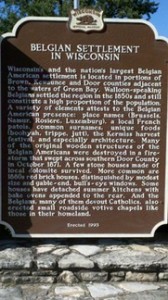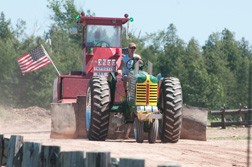Retaining An Identity
- Share
- Tweet
- Pin
- Share

One of 21 roadside chapels in the Belgian settlement. Photo by Dan Eggert.
When Bill Laatsch joined the geography faculty at the University of Wisconsin – Green Bay in 1966, his specialties were the Arctic and mountainous areas of the world. Advised to choose a local community for research, he became fascinated by the Belgian settlements between Green Bay and Sturgeon Bay, with their unique building style and culture and their intense devotion to family and church. Forty-five years later, after retiring as Professor Emeritus of Urban and Regional Studies, Laatsch is a nationally-known expert who continues his work with the area, home to the largest number of Belgians outside Belgium.
Its history goes back to the mid-19th century, when the failure of crops, a cholera epidemic and the disappearance of home industries like weaving caused thousands of Walloon Belgian families to emigrate to America. Many of them, whose language was a lingo of French, stopped first in Sheboygan, but moved on to Green Bay when they heard there were other French-speaking people there.
Later, the group followed Father Edward Daems, a Walloon priest, to the area that became the village of Champion.
“Father Daems didn’t do them any favors by bringing them to the ‘rock pile’ of Door County,” Laatsch says. “But it was not the landscape that drew them – even at $1.25 per acre – but the devotion to their religion and language, their families and customs.”
Between 1853 and 1857, thousands more Walloon Belgians followed the first wave, settling in a 100-square mile area in Door, Kewanee and Brown counties. Laatsch describes Wisconsin as “a sea of Germans with small islands of other nationalities, such as the Polish in Pulaski and the Swiss in New Glarus.” But, while populations in the other “islands” have become less homogenous over the years, the Belgian communities of Namur, Brussels, Rosiere and Little Sturgeon in Door County and 11 other villages in Kewaunee and Brown counties have retained much of what made them unique more than a century and a half ago.

A plaque honoring the
historic landmark status of the Belgian Settlement outside St. Mary of
the Snows. Photo contributed by Bill Chaudoir.
This includes aspects of their material culture – house types, summer kitchens with outdoor ovens, barns and roadside chapels – and non-material culture – the Walloon language, distinctive diet, strong ties to their Catholic religion and the family.
After the great fire of Oct. 8, 1871 obliterated the town of Brussels and killed hundreds, families rebuilt their homes with facades of red bricks made from local clay. The square, two-story houses with arches over the windows are still a familiar sight. The Belgian summer kitchen was a separate building, unique in that a huge bakeoven that could hold 24 loaves of bread or 30 of the seven-inch Belgian pies was attached to one side.
Early barns were mostly made of logs, but other outbuildings – even the proverbial outhouses – were often brick.
Twenty-one roadside chapels were identified in the Belgian settlement in 1992, mostly in the Rosiere area. They are tiny, ranging from just over 30 square feet to 120 square feet, and are usually made of wood with French inscriptions above the door. Most are privately owned but are open to all.
Like the style of their buildings, the Belgians brought with them a fierce devotion to their religion and to family. The first Catholic church in the area, St. Mary of the Snows, was built in Namur in 1860. Churches helped to insure the preservation of the Walloon dialect, with many holding services solely in that language well into the 20th century. They were also the center of the village’s social life with activities such as the annual two- or three-day Kermis or harvest festival, featuring chicken booyah, prune, raisin and rice Belgian pies, jut (boiled cabbage with mashed potatoes) and trippe (pork sausage with cooked cabbage and spices), along with games, dancing to brass bands and lengthy visits to the nearby taverns.
The fact that the smaller Belgian villages and farms were close to the larger settlements of Green Bay, Sturgeon Bay, Kewaunee and Algoma meant that when a farm could no longer support all the children in a family, they could find work nearby. If they did not return home each night, they at least returned on weekends. Thus, they continued to be part of the nuclear family, holding true to its religion, customs and diet. Change came much slower to the Belgian communities than to other “islands” where young people had to move a distance away to find employment.
In 1990, a six-square-mile area around the village of Namur was designated a National Historic Landmark. “Most people don’t realize what a big deal this is,” Laatsch says. “This puts Namur in the same category as the Gettysburg Battlefield and Arlington National Cemetery.” The heart of Namur’s Belgian identity was St. Mary of the Snows Catholic Church. In 1999 the diocese decommissioned the church and planned to raze it. Last year, the building was purchased by Laatsch, George Evenson, Bill Chaudoir and Allen and Theresa Alexander, who plan to turn it into a Belgian Heritage Center.

Residents celebrate the rich agricultural heritage of the settlement
at Belgian Days each July. Photo by Dan Eggert.
“If the church had been destroyed,” Laatsch says, “Namur would have been in danger of losing its designation as a National Heritage Site.”
A generation or two ago, 80 percent of the land in the area was still owned by descendants of the original Belgian settlers. Today it’s a bit less. Laatsch suggests three reasons: Growth of the university and community college systems has meant that more young people have been educated and moved to metropolitan areas. Aging farmers are selling their land. (“It’s the farmer’s ‘social security,’” Laatsch says. “Their kids don’t want to take over the farm.”) High land prices in Northern Door County make five acres in the Belgian settlements very appealing to urbanites who want a piece of Door County.
Still, the persistence of the Belgians in maintaining their location and culture through so many generations is incredible.
“We all share the Belgian story,” Laatsch says, “because we are all immigrants. The wealth of the U.S. is due to its diversity, and we can all learn by studying this valuable area.”
Some information in this story is based on a chapter by
William Laatsch and Charles Calkins in the 1992 book
To Build a New Land: Ethnic Landscapes in North America.
